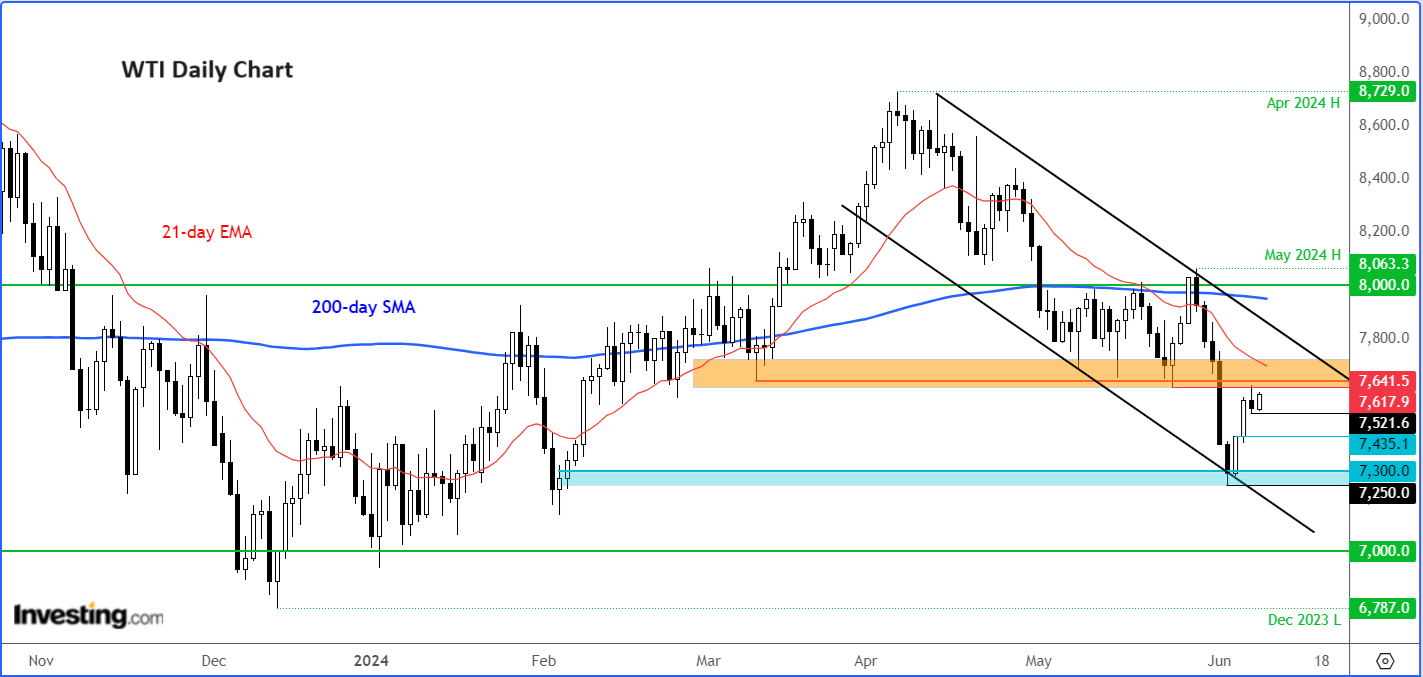- Oil prices rebounded slightly after weeks of losses, but remain pressured by supply concerns.
- Key events this week like US inflation data and Fed decision could impact oil prices through the dollar.
- Despite the rebound, the short-term outlook leans bearish with resistance at $76 and support at $73.
- Invest like the big funds for under $9/month with our AI-powered ProPicks stock selection tool. Learn more here>>
Crude oil prices edged higher in the early trade on Monday, making back some of its losses from Friday. While there is hope for increased fuel demand as we head to the summer months, today’s small recovery comes on the back of a three-week drop.
Prices have been held back in recent weeks because of various factors, ranging from concerns over increased non-OPEC supply and worries about the demand outlook, due, among other reasons, to diminished hopes over imminent US interest rate cuts. The strong dollar recovery is also weighing on sentiment in the oil market. But with prices shedding more than 10% from their April highs, the bulls feel the downside could be more limited moving forward.
However, a revisit of last week’s lows of around $72.50 on WTI remains the more probable outcome than a sharp recovery. Key macro events this week include US inflation data and the Federal Reserve’s rate decision on Wednesday, both of which could significantly impact the US dollar and, consequently, buck-denominated commodities like gold and oil.
Oil prices closed lower last week
The crude oil selling resumed on Friday after a two-day pause. While the losses were milder than earlier in the week and less severe than the drop in metals, this was due to a strong jobs report and positive services PMI data that alleviated fears of weakening demand in the US.
Nonetheless, concerns over China persisted, leading to lower prices for the week. The sell-off in other commodities like copper and silver also spooked investors. The selling was also driven by speculative long positions being pared last week by managed funds and large speculators. Not only that but they also increased their short positions last week, resulting in a decrease in net-long exposure.
According to positioning data from the CFTC, managed funds increased their short positions by 27.2k contracts, while large speculators increased theirs by 22.1k contracts (21.9%). This positioning data reflects the market response to OPEC's decision to extend oil production cuts. It suggests that traders either anticipated more aggressive support for prices from OPEC, are concerned about declining demand due to a slowing economy, or likely a combination of both factors.
Why did all major commodities fall on Friday?
The sharp fall in major commodity prices on Friday was driven by a rally in the US dollar, which negatively impacts dollar-denominated commodities. This rally was triggered by stronger-than-expected job growth, even though part-time jobs contributed to this increase.
Metals were already under pressure before the jobs report due to concerns over lower-than-expected Chinese demand for industrial metals and rising copper stockpiles. Additionally, the People’s Bank of China halting its gold purchases in May after an 18-month streak also pressured precious metals, contributing to bearish sentiment in the commodities market.
What has been driving oil prices recently?
Oil prices have been primarily driven lower by demand concerns and an increase in non-OPEC supply. According to the International Energy Agency (IEA), there is a significant surplus of oil this year, largely due to the growth in US shale production. Consistently weak manufacturing data worldwide has heightened demand concerns.
This was particularly evident when crude oil prices dropped to their lowest level since February following weak US factory data. The OPEC+ decision to extend output cuts failed to support oil prices as it was already priced in, and there are worries about phasing out voluntary output cuts amid rising non-OPEC supply. However, with the US driving season underway, demand might pick up, potentially slowing or reversing the sell-off.
No strong bullish reversal signs have been observed, however, which means the short-term path of least resistance on oil remains to the downside.
Crude Oil Technical Analysis and Trade Ideas
The recent drop in oil prices has established a clear resistance level between $76.00 and $76.50 on WTI, which was tested and held on Friday. This will be a crucial resistance area to monitor in the coming week.

As long as prices remain below this zone, the bearish trend will continue.
There was an oversold bounce last week, but a decline towards the support trend of the bearish channel, around the $73.00 mark or slightly below, is possible this week. WTI has been stuck in a bearish channel since peaking in April.
The next major support level below the bearish channel is at $70.00, followed by the December low at $67.87.
However, if WTI were to reclaim the old broken support area between $76.00 and $76.50, it could signal a bullish trend, potentially leading to technical buying towards the top of the bearish channel, between $78.00 and $79.00.
***
Be sure to check out InvestingPro to stay in sync with the market trend and what it means for your trading. As with any investment, it's crucial to research extensively before making any decisions.
InvestingPro empowers investors to make informed decisions by providing a comprehensive analysis of undervalued stocks with the potential for significant upside in the market.
Subscribe here for under $9/month and never miss a bull market again!

Disclaimer: This article is written for informational purposes only; it does not constitute a solicitation, offer, advice, or recommendation to invest as such it is not intended to incentivize the purchase of assets in any way. I would like to remind you that any type of asset, is evaluated from multiple points of view and is highly risky and therefore, any investment decision and the associated risk remains with the investor.
